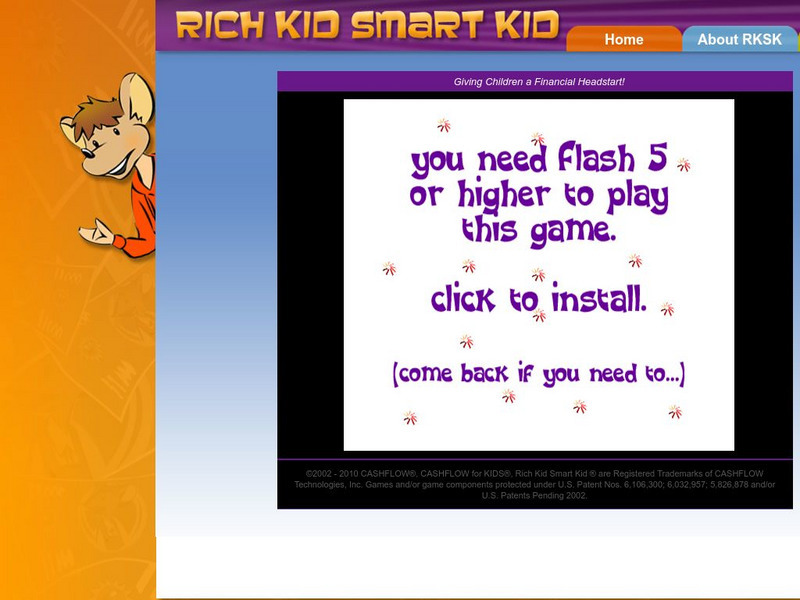Thinkport Education
Maryland Public Television: Sense and Dollars
Engaging, fun tutorials and interactive games related to earning, spending, saving, and budgeting money.
Other
Economic Awareness Council: Saving and Investing [Pdf]
Learn the advantages to saving money, some different types of savings plans, and some ways even people with small amounts of money can invest money to fund long-term goals.
Other
Rich Kid Smart Kid: Ima's Dream
Animated learning games for students in all grades K-12, teaches them about basic finance, how to save, give and invest.
Council for Economic Education
Econ Ed Link: A Penny Saved
Students will read the comic book, "A Penny Saved" published by the New York Federal Reserve Bank. Students will make the information relevant through projects, graphic organizers, teacher instruction, and problems.
Council for Economic Education
Econ Ed Link: Saving and Investing
Website with interactive activity and video teaches students about saving and investing.
Other
In Charge: Financial Literacy for Kids
The following lessons provide guidance, lesson plans, and activities for teachers interested in introducing financial literacy concepts to students in grades K-6.
Council for Economic Education
Econ Ed Link: Big Banks, Piggy Banks
When choosing a place to put their money, people consider how safe there money will be, how easy it is to access, and whether it will earn more money. Students explore how well different savings places achieve these objectives. This...
Council for Economic Education
Econ Ed Link: Saving and Investing Blitz
Interactive activity-based resource on economic concepts of saving and investing.
Council for Economic Education
Econ Ed Link: Opportunity Cost
Consumers are faced with tough choices because so many innovative and exciting products and services are available. Therefore, engraining a decision-making process that includes considering of opportunity cost is necessary to shape...
Goodwill
Gcf Global: Living Within Your Means
Tutorial provides handy tips for living within your means.
Federal Reserve Bank
Federal Reserve Bank of St. Louis: The Pickle Patch Bathtub [Pdf]
A lesson based on The Pickle Patch Bathtub by Frances Kennedy, where students learn about making choices in how to spend money, and how to set goals and develop a savings plan.
Practical Money Skills
Practical Money Skills: Save a Million
Practical skills in finance and economics teach students about saving, budgeting, and retirement. Students can calculate what it takes to become a millionaire based on their age and income.
Council for Economic Education
Econ Ed Link: Buy a Bond, James: A Lesson on Us Savings Bonds
This site is extremely informative for teaching children the value of saving money. "You will write a persuasive letter telling why people use savings bonds as a way to save their money."
Council for Economic Education
Econ Ed Link: Climbing the Savings Mountain
Students discover how saving money can be compared to a mountain climb. The climb can be fast or slow, safe or hazardous, scenic or thrilling. You will find out that there is more than one way to get to the top!
Council for Economic Education
Econ Ed Link: Climbing the Savings Mountain
Check out this lesson plan to learn how to develop a savings plan that is right for you.
Other
Wells Fargo: Hands on Banking: Elementary School Course
Learning game for younger students in a lesson in economics in which students learn about banking, saving, budgeting, and money.
Practical Money Skills
Practical Money Skills: The Payoff
Help Alex and Jess make smart financial decisions within the tight three-day deadline and complete their video for the competition in this experiential game.
Other
Federal Deposit Insurance Corporation: Consumer Resources
A great resource from the FDIC for "becoming an informed banking consumer." Learn all about consumer protection and gain important and useful facts about such topics as phishing scams, identity theft, consumer rights, new cheque clearing...
Other
American Institute of Certified Public Accountants: Feed the Pig
What kind of saver are you? Save the Pig has great tips and tools to help you identify your spending habits and then learn to change them in order to improve your financial health.
Other
California Jump Start: Money Rules 4 Kids
Ten money rules that every high school kid should know, available in both English and Spanish.
Practical Money Skills
Practical Money Skills: Money Metropolis
Money skills game teaches students how to make money and what to do with it once they have earned it.
Scholastic
Scholastic: Adventures in Math: Lesson 4: How to Use Your Money
In this lesson plan, young scholars will identify why having a budget and keeping records of their spending and saving habits helps them make better financial choices.
Consumer Financial Protection Bureau
Consumer Financial Protection Bureau: Investigating Investing
Students explore the U.S. Securities and Exchange Commission's investor.gov website to learn about some common types of financial investment products.
Consumer Financial Protection Bureau
Consumer Financial Protection Bureau: Comparing Saving and Investing
Young scholars explore the differences between saving and investing and answer questions about which one they'd use to reach different financial goals.



![Economic Awareness Council: Saving and Investing [Pdf] Activity Economic Awareness Council: Saving and Investing [Pdf] Activity](https://d15y2dacu3jp90.cloudfront.net/images/attachment_defaults/resource/large/FPO-knovation.png)








